(Thank you to Louise who asked us to look into the creatures and features of our city! This one is for you but is also for all of you looking to learn a bit more about the hidden parts of Norwich!)
Norwich is full of lots of hidden creatures and features that watch us in our everyday movements. To those of us that live here, the streets of Norwich are a familiar sight. Many of us probably think we know all there is to know in terms of places and features in the city. However, there are many hidden aspects of Norwich. Things that are just out of sight to the usual pedestrian or innocuous objects we pass everyday that have a hidden story of meaning. Whether they are hidden statues, markers for medieval ditches or devices designed to stop men from urinating, there’s a lot around Norwich that may make you want to go and take a second look around with fresh eyes!
The Statue of Amelia Opie on Opie Street
To most of us, Opie Street is a small, unremarkable space leading away from Castle Meadow towards the Lanes. The street, however, was once a place of crime and sin, being utilised as the city’s red light district for many years. It was named “Turpis Vicus” or “shameful street” but its other name is not one I cannot publish on here and still keep my job. Safe to say, I’d only google it when your Grandma isn’t in the room.

The street was named “Opie Street” following the death of beloved literary icon and philanthropist Amelia Opie in 1853. She was born an Alderson and from a young age she discovered her love of writing. Her books are still in print and possible to buy online including her first published novel ‘The Dangers of Coquetry’ (flirting) that she published aged 22. She also was a huge advocate for positive social change, focussing mainly on poverty and bigotry in England as well as England’s role in the slave trade in the Americas. Her confidence, intelligence and beauty disarmed most of those conservatives who would be otherwise outraged at her beliefs. She went on to marry John Opie, a famous painter, but he passed away eight years into their marriage. Despite other suitors stepping forward to try and win Amelia’s hand in marriage, she decided to remain single, opting instead to focus on her work. She passed away at 84 years old, a decent age for back then!
The road became Opie Street (potentially trying to turn attention away from its ‘sordid’ past) and a small statue of Amelia was placed on a nearby building. Usually as we walk down it, we don’t tend to look up at the tops of the buildings above us. So, next time you find yourself on Opie Street, take a quick look up above the Gelato shop open there currently, and you can see Amelia in her bonnet looking down at you from above!
Parish Boundary Markers
These small, metal squares, hidden around our city are parish boundary markers. As the name suggests, they marked out the boundaries of the various parishes around the city. This was necessary due to the unusual layout of many of the parishes and the fact that there were no maps of them readily available to the public! The parish was a crucial part of society for many centuries and would act in a similar fashion to a local council. Births, deaths and marriages were all monitored and recorded by the parish. Taxes were usually paid to the parish and it also dictated where you went to church for regular services. Civic responsibilities lay with them until the end of the 19th century.

The markers were usually made of lead or stone and have the date the boundary was set. A second date is sometimes included to show when the boundary layout was officially accepted. The initials determine the parish itself and sometimes there is a symbol associated with the saint that the parish is named after.
There was a tradition a few days after Easter named Beating The Bounds. This involved the parish coming together and being led by the church Deacon around the borders of their parish. Each boundary marker would be paused at and a stick used to strike the markers while prayers were said. It was believed that this would bring luck to the parish for the rest of the year to come. During this event, it was also customary to bring choir boys who had missed a service or forgotten the parish boundary layouts and they would have their heads knocked against the markers themselves or the wall so they wouldn’t forget in future!
Anti-Urination Devices
You might have re-read that title a couple of times now but I promise you’re reading it correctly! These strange and often hidden small structures can be found all over Norwich. Once you get your eye in, you will start to spot them everywhere! As the name suggests, this architecture was designed with the specific intention of stopping men from urinating against buildings.

In the 19th Century, Norwich had many more pubs than we do today. We say that there was once a pub for every day of the year in Norwich but the real figure in the early 1800s stood closer to 700 pubs. Compare that with the number of urinals or public toilets, of which there were none, and you can start to see the building blocks for the problem. The mortar that we used in construction at that time wasn’t cement, but was actually made of a mortar called lime. Lime, it turns out, dissolves when it comes into contact with urine.
Around 11pm at night, the 700 or so pubs around Norwich would unleash hordes of drunken men onto the streets. Often these men would go down the alleyways to relieve themselves and were doing so in such large numbers that they were, in some cases, completely wearing away the mortar in the walls. This was causing significant damage. As a result many property owners took to building homemade defences to try and stop this from happening. Anti-Urination Devices (or AUDs) come in all shapes and designs as a result. Most look like concrete lumps or sloped parts of walling and were designed to deflect a stream of urine back into the offender’s face or onto their shoes. However, variations existed, some of which had barbed spikes at crotch level that would be painted dark grey to hide them in the dark! Others looked like fencing or railings that would cover the corner of a building to stop men getting close enough to urinate there.
The Red Bollards of The Lanes
If you find yourself wandering around in the vicinity of the Norwich Lanes, you might start to spot the curious red bollards with bronze sculptures on top. The bollards themselves are Victorian and would have originally been painted a dark green rather than the startling red you see today!
The repainting of the bollards and the addition of the bronze sculptures (designed and made by Oliver Reed) came as part of a project to add a few visual clues as to the history of each area. The reason the red was chosen was to match the “Madder Red” colour that used to be produced in Norwich as a dye for our thriving weaving industry. Originally reserved for the clothing of the Tudor royal family, Madder Dye became more widely available in the 17th Century where it was sold at the Maddermarket that still exists today around the theatre.
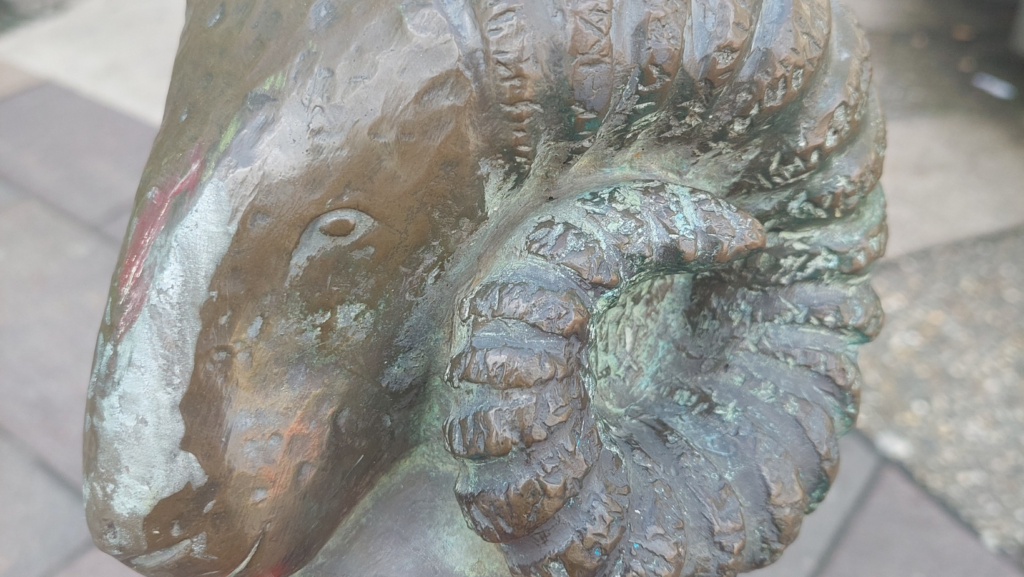
The bronze toppers either reflect the street name such as on Swan Lane, or a little nod to the history. Take the ram’s head in the image above for example. The reason it sits on that area of London Street is because the area used to be home to horn workers who would use ram horn as a material to make jewellery and assorted other goods.
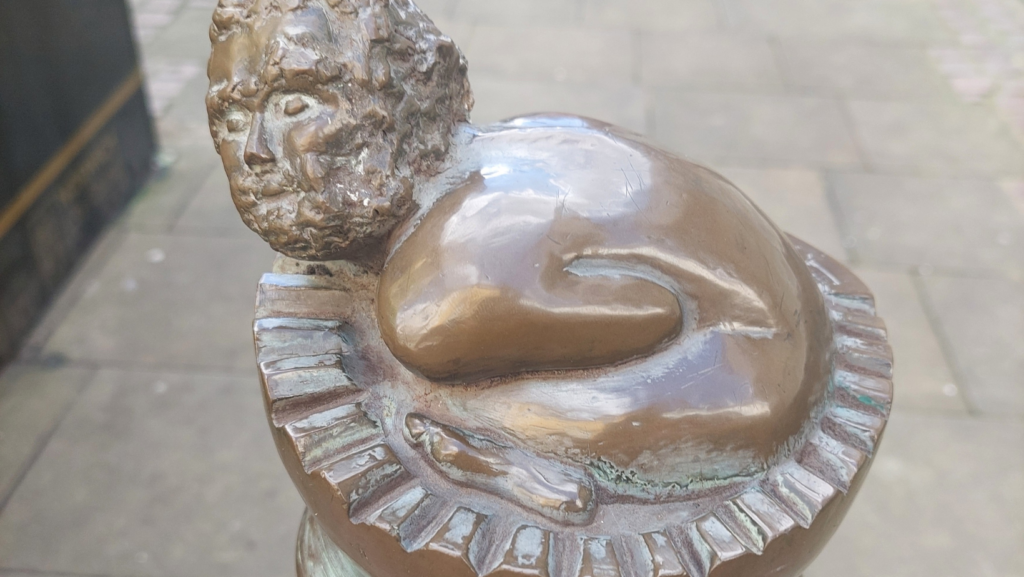
As for the bronze figure of the strange, squatting, naked man, this is an effigy of Peter the Wildboy. Peter was a genuine wild child much like Mowgli from the Jungle Book. He lived feral in the woods of Hamlin, Germany in the early 1700s, but was found by King George I of England who was there on a hunting trip. He was described as walking on all fours, unable to speak and living off of the flora found around the area. George had him captured and brought back to England where he was kept almost as a pet by the Fenn family in Hertfordshire. One day, Peter escaped and fled across the country. He couldn’t be traced but a few years later a fire broke out at Norwich Bridewell Prison and as the inmates were evacuated, one was described as “behaving like an orangutan” with no speech, a strange walk and a lack of understanding of the world. Realising who he was, he was shipped back off to Thomas Fenn, where he was fitted with a leather collar. Peter lived until the ripe old age of 73 (impressive for the time) and was described in his older years as healthy, well-dressed and capable of basic conversation but he still preferred to speak in grunts.
The Roof Bosses of the Cathedral Cloisters
Any person visiting the grand cathedral in Norwich usually spots the weird and wonderful roof bosses that adorn the cloisters and the nave. The cathedral has over 1000 of these beautifully carved roof decorations and they show an array of different scenes, creatures and figures.

They first came about after a great riot in Norwich in 1272. The church based in the cathedral had been unfairly taxing the people and had caused quite a lot of unrest. It culminated in a cathedral worker firing a crossbow into a crowd gathered in Tombland, killing a small boy. In retaliation, the people of Norwich laid siege to the cathedral and fired burning missiles from the top of nearby St George’s church. The wooden roof of the cathedral cloisters burned like tinder and was completely destroyed.
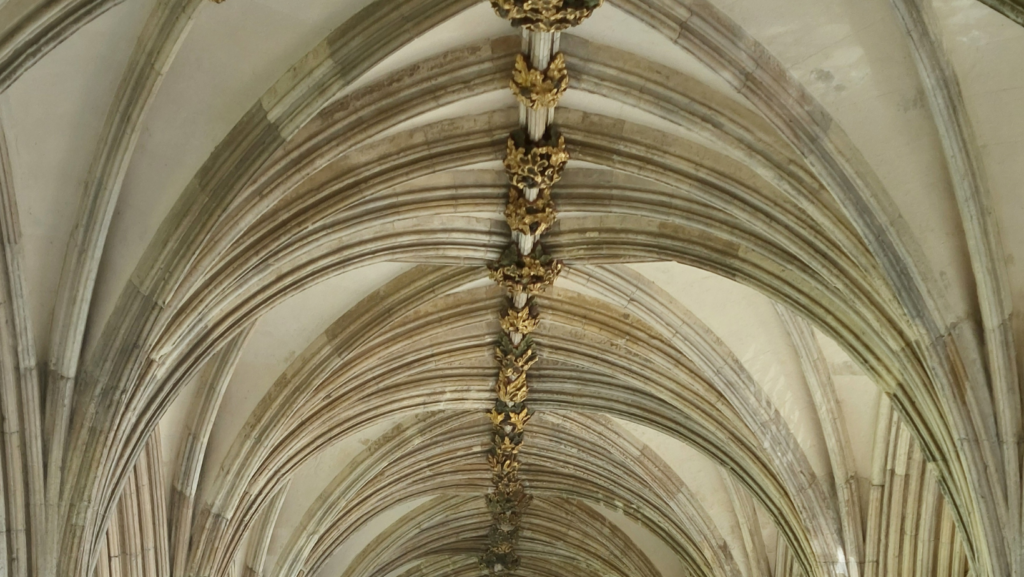
It was decided to rebuild the roof in stone and many incredibly skilled craftsmen were brought in to complete the project. The arches in the cloisters were designed to look like over-arching tree branches and the bosses themselves also carry a lot of natural imagery, with many of them adorned with leaves, acorns and other plant life. The bosses were keystones, the main stones in the middle of the arches that took the pressure and held them up. The stones were placed from above and then the craftsmen would have to carve them from below once they were in place. Each boss took two weeks to carve, and it took 150 years to complete the project.
Masons were respected and paid well. The average 14th century mason would be paid 4 shillings and 20 pence per week (a barber for comparison was paid tuppence a week), and a master mason would receive a bonus in the form of a uniform, a tunic, hat and gloves worth five weeks wages. The masons were so well-respected that they were called upon over most of southern England for their skills and even helped to build Ely cathedral. The images used in the bosses were taken from illuminated manuscripts and, in fact, there is evidence to show that they had to buy new manuscripts every so often as they would wear out the ones in their possession. In 1463, the nave of the cathedral was struck by lightning and the roof collapsed, so it was decided to follow the theme of the cloisters by rebuilding it in stone and adding additional roof bosses that, from East to West, tell the Christian story of Creation through until Judgement Day.
Many different themes and stories can be found amongst the images. It is thought that this was the first instance of a story being told in roof art and so the bosses became very popular. Interestingly, some of the imagery is distinctly pagan. A lot of natural imagery of beasts and forest gods (often dubbed “The Green Men”) can be seen amongst them. This could be attributed to the fact that this earlier form of English Christianity still held onto Pagan themes as those far more ancient traditions could still be found in pockets around the fringes of society.

Later, there are Christian themes. The execution and resurrection of Christ, the death of John the Baptist and the “Harrowing of Hell,” where Jesus pulled souls from Hell itself including those of Adam and Eve. A large portion of the cloister bosses (over 90) are dedicated to showing the apocalypse. Mountains burst into flames, seas turn blood red and angels capsize boats. Great towers of men crumble and enormous monsters swallow people alive. This was to show the end of the journey that Christians believed all human souls would have to endure in the final days of the world.

There are also more quirky and comedic bosses such as some showing monks having manuscripts snatched by animals. On one above a doorway in the cloisters, a young man bares his buttocks and makes as if to defecate on the people below! Another common theme is that of women beating men or fighting them and this was thought to be a tactic for monks who had sworn off marriage. The bosses showed them that, with all the (supposed) conflict in marriage, they weren’t missing out on anything! Some of the bosses show battle scenes which would make sense as many were carved during the war with France and the battle with Agincourt which would be the main news in the early 1400s. It is also likely why many of the biblical figures are seen wearing 15th century clothing as it would be more recognisable to the people at the time.
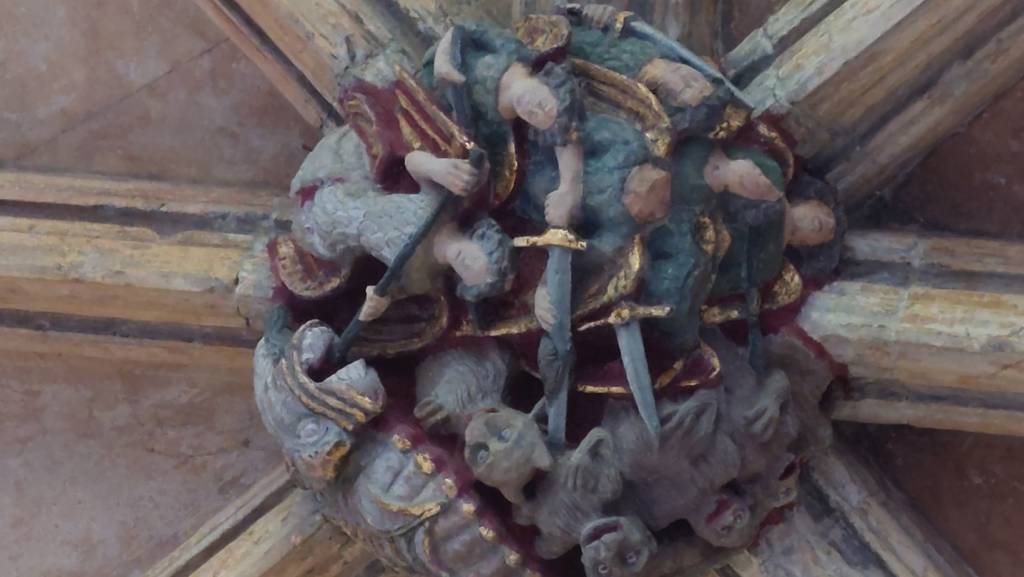
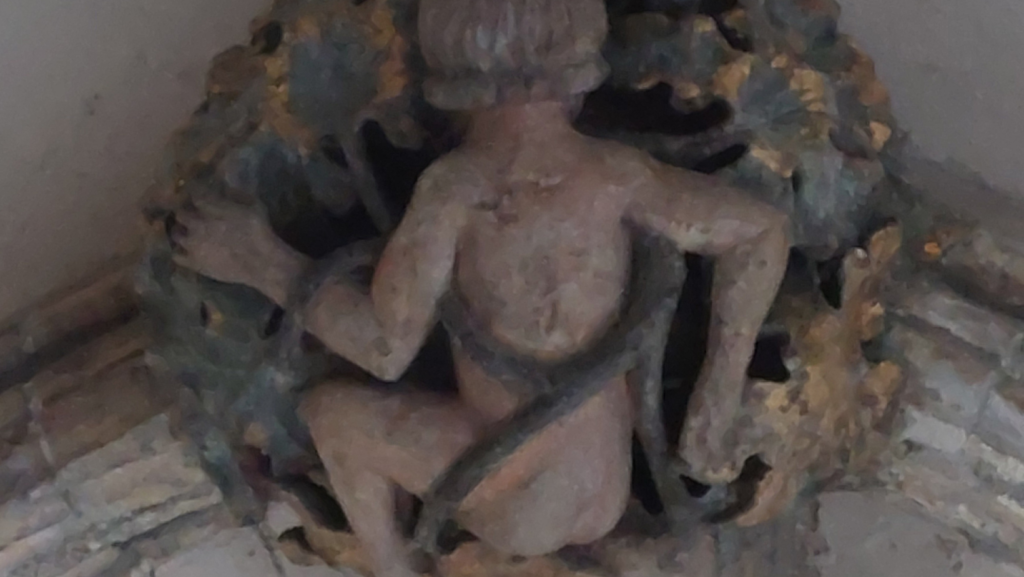
These bosses were very useful at a time when only a small percentage of the population would have the ability to read and write. They could walk the cloisters and see the stories in images rather than having to struggle with any books. Some of them have sadly been vandalised and many were damaged during poor attempts to restore them at the beginning of the 20th century, but they still command an impressive presence to anyone walking around the incredible structure.
References
Colonel Unthank Street Furniture
Stories In Stone (Roof Bosses of Norwich Cathedral)
THANK YOU
This post was inspired by Louise who generously contributed to our Crowdfunder helping to secure our space for our community and allowing us to continue producing the experiences that are proving so popular!